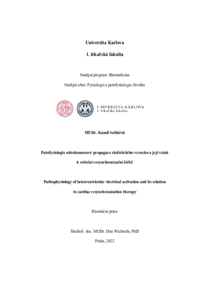Patofyziologie nitrokomorové propagace elektrického vzruchu a její vztah k srdeční resynchronizační léčbě
Pathophysiology of intraventricular electrical activation and its relation to cardiac resynchronization therapy
dissertation thesis (DEFENDED)

View/
Permanent link
http://hdl.handle.net/20.500.11956/178028Identifiers
Study Information System: 196768
Collections
- Kvalifikační práce [4870]
Author
Advisor
Referee
Linhart, Aleš
Čurila, Karol
Faculty / Institute
First Faculty of Medicine
Discipline
Human Physiology and Pathophysiology
Department
2nd Department of Medicine - Department of Cardiovascular Medicine First Faculty of Medicine Charles University and General University Hospital in Prague
Date of defense
20. 10. 2022
Publisher
Univerzita Karlova, 1. lékařská fakultaLanguage
Czech
Grade
Pass
Keywords (Czech)
srdeční selhání, srdeční resynchronizační léčba, blokáda levého Tawarova raménka, optimalizace terapieKeywords (English)
heart failure, cardiac resynchronization therapy, left-bundle branch block, therapy optimizationSouhrn Zúžení komplexu QRS při srdeční resynchronizační léčbě (CRT) je spojeno se zlepšenými výsledky této terapie. V této práci jsme testovali 2 výzkumné hypotézy: (1) absence prodloužení komplexu QRS při pravokomorové septální stimulaci je markerem kompletní blokády levého Tawarova raménka (cLBBB); (2) elektrický interval mezi pravokomorovým stimulem a lokálním signálem na levokomorové elektrodě (RVP-LV) odráží lépe elektrickou konfiguraci pravokomorové a levokomorové elektrody a je lepším prediktorem elektrokardiografického efektu CRT než interval Q-LV. Prospektivně jsme zaznamenávali 12-svodová EKG a intrakardiální elektrogramy při implantacích CRT. Digitalizovaná EKG a intrakardiální záznamy byly editovány a manuálně měřeny. Hlavním studovaným cílem byla změna šíře komplexu QRS při CRT (deltaCRT). Testovali jsme následující prediktory deltaCRT: nativní šíře komplexu QRS (QRSd), cLBBB (definice podle Strausse), intervaly Q-LV a RVP-LV a podle studijní hypotézy také nový ukazatel definovaný jako rozdíl mezi QRSd při pravokomorové stimulaci a nativní QRSd (deltaRVP). Do studie jsme zařadili 133 konsekutivních pacientů. Zjistili jsme, že nativní QRSd, deltaRVP a interval Q-LV představují silné nezávislé prediktory elektrokardiografické odpovědi na CRT (deltaCRT). DeltaRVP eliminuje v prediktivitě hodnotu...
The QRS complex shortening by cardiac resynchronization therapy (CRT) has been associated with improved outcomes. We hypothesized that (1) the absence of QRS duration (QRSd) prolongation by right ventricular septal pacing may indicate a complete left bundle branch block (cLBBB), and (2) that the interval between the right-ventricular pacing stimulus and left-ventricular lead electrogram (RVP-LV) is a better predictor of the electrocardiographic effect of CRT than the interval Q-LV. We prospectively collected 12-lead surface ECG and intracardiac electrograms during CRT implant procedures. Digital ECG and intracardiac recordings were edited and manually measured. The outcome measure was the QRS duration change induced by CRT (deltaCRT). Several outcome predictors were investigated: native QRS duration (QRSd), cLBBB (as defined by Strauss), Q-LV and RVP-LV intervals, and a newly proposed index defined by the difference between the right-ventricle-paced QRSd and native QRSd (deltaRVP). We included 133 consecutive patients in the study and found that the baseline QRSd, deltaRVP, and Q-LV represent strong independent predictors of electrocardiographic response to CRT (deltaCRT). DeltaRVP correlates tightly with the CRT effect on QRSd and outperforms predictive value of the ECG-based cLBBB. Strong...
